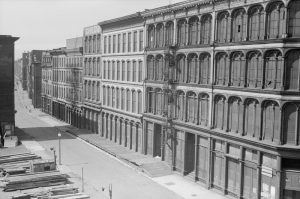Inevitably, designers respond to crisis with… design.
The world of 2020-2021 is grappling with a devastating pandemic, protests against racism and inequity, and demands to shift resources: from policing to community building, from fossil fuels to green energy, from shareholders to stakeholders, from short-term profit motivation to sustainability and resilience.
These are lofty and noble ideals viewed from our current reality. Designers – namely the architects, structural engineers, and civil engineers of our industry – are hard at work, pondering how to design and construct our way through these challenges. And, rightly, we should. But, critically, we must also remember the ugly truth of history, when past “good intentions’’ have led to disastrous outcomes.
From the 1930s to 1960s, Robert Moses led public construction in the New York City metropolitan area. He pushed forward public works projects viewed by the dominant society as providing needed improvements and renewal, and in so doing, creating highways, new buildings, and suburban housing, resulting in jobs for designers and engineers. Unfortunately, the side effects were sprawl and the razing of poor neighborhoods (e.g., East Tremont in the Bronx, as vividly described in The Power Broker by Robert Caro), while hindering mass transit, equitable housing, and access to parks for non-white people. Today, we struggle to undo the misdeeds of that era.
Moses’s New York is just one example of the type of ‘’urban renewal’’ that would later be judged as misguided. A few more examples:
In the early 1900s, racial covenants in Los Angeles limited where non-whites could purchase property. One of those few places was an area known as Chavez Ravine, a close-knit community of primarily Mexican-heritage families. After the 1949 National Housing Act, the Los Angeles (LA) City Housing Authority made the harsh and dubious decision to classify Chavez Ravine as a “slum,” and the city began evicting residents to make way for, ironically, a mass housing project. Ultimately, political disagreements among city lawmakers stalled the housing project, and the owner of the (formerly Brooklyn) Dodgers swooped in to buy the land for a new stadium. In 1959, LA sheriff’s deputies physically dragged the last holdout families from their houses, with the traumatic images plastered on television and newspaper front pages.

The origin of St. Louis’s Gateway Arch – a structural engineering marvel, to be sure – is also rather troubling. The city’s central riverfront had been home to a thriving African-American community, with historic blocks of cast-iron buildings reminiscent of Manhattan’s SoHo district. In 1935, white business leaders proposed a massive monument to Thomas Jefferson and the Louisiana Purchase. They rigged a bond measure vote (including tens of thousands of phony ballots) to ensure its authorization. In 1939, demolitions began, and ultimately 486 structures over 40 square blocks were bulldozed – including 290 businesses, mainly small factories employing some 5,000 workers. The area sat desolate during WW II, but post-war highway development infused federal dollars (aided by fellow Missourian President Harry Truman) to complete the project. This permitted highways to run through downtown St. Louis, which further cut off local residents (mainly poor and non-white) from access to the waterfront and future park. In 1964, construction of the Arch was underway. Still, African-Americans were essentially excluded from working on the construction teams: finally, protesters climbed the Arch while it was still under construction and, ultimately, won promises for fairer hiring at the site. But the damage was already done.
Similar stories of brutal “renewal” occurred at the development of Philadelphia’s Independence Mall in the 1950s, San Francisco’s Western Addition in the 1950s (which resulted in the loss of many of the famous Victorian buildings), and elsewhere. Granted, these examples were developed around societal philosophies and norms (at least for those in power) of their times. However, that does not mean that history should not inform our decisions today.
For our present and future, I have no magic spell or secret recipe to avoid a repeat of past mistakes… except to get involved! You probably know as much about the issues involved as the so-called experts. Come to the debate with facts and ideas. If necessary, educate yourself about both the bad and good sides of history. Then insert yourself into current policy debates and decisions in your locale. Lean on your politicians to get your opinions heard and acted on. Apply your engineering approach to see the reality of the issues and what alternatives exist before designing what others would think the future to be.
And carry with you a dose of humility: About the past mistakes – yes, mistakes – of architecture and engineering.■
